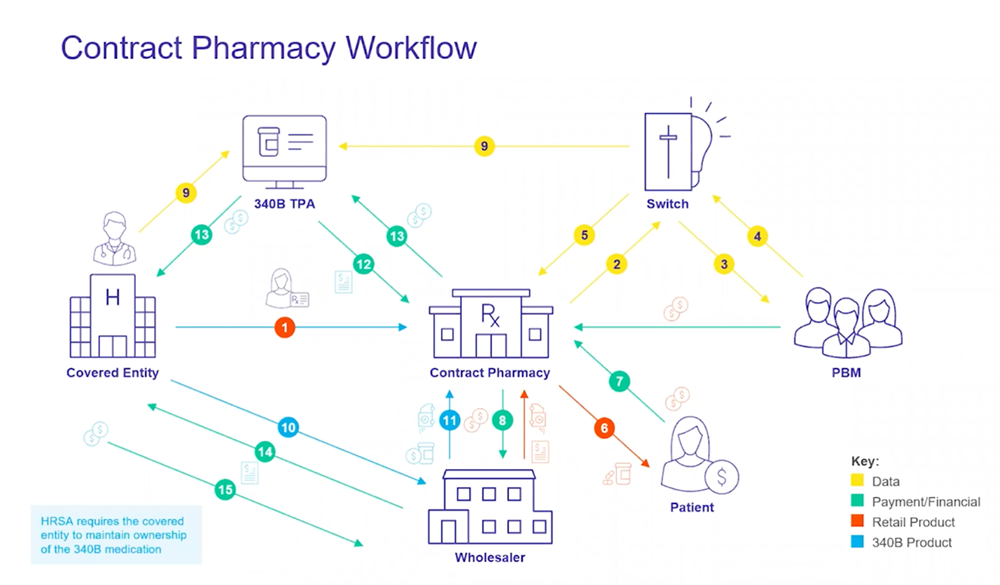How are retail prescriptions captured into the 340B program?
By AmerisourceBergen
What pharmacies need to know about 340B workflow
The principal parties involved in a 340B partnership are the covered entity, the third-party administrator (TPA), and the contract pharmacy. The TPA provides software services that enable the covered entity to identify 340B-eligible prescriptions dispensed at a contract pharmacy. Through this arrangement, the TPA minimizes the disruption to the pharmacy's regular operations because pharmacy staff does not have to determine if retail prescriptions are 340B-eligible.
Additionally, a contract pharmacy does not need to maintain a separate inventory for 340B-eligible drugs, but instead can utilize a “virtual" inventory. The pharmacy receives a replacement product, paid by the covered entity, after a full package size has been dispensed to a 340B-eligible patient (or patients). Most contract pharmacies use a virtual inventory model in which the TPA captures claims retrospectively and then replenishes the product, as opposed to manually maintaining a physically separate inventory requiring staff-intensive point-of-sale qualification. Pharmacies using a physical inventory spend much more time and effort managing the 340B program than those using a virtual inventory model with the help of a TPA.
The TPA leverages the covered entity's electronic medical records (EMR) data and the pharmacy's switch data to qualify eligible 340B prescriptions. Then, the TPA administers the contract terms in the pharmacy service agreement (models for claims, dispensing, and billing) and applies specific business rules outlined in the contract. Once the TPA captures a prescription and a full package quantity is reached, a replenishment order is generated through the contract pharmacy's wholesaler. Note that the covered entity—not the pharmacy—pays the administrative fees charged by the TPA.
340B contract pharmacy workflow
Let's walk through a hypothetical scenario with a patient visit resulting in a new 340B-eligible prescription. The numbered steps below match the numbers on the Contract Pharmacy Workflow diagram.

- A patient leaves a qualifying visit at a covered entity with a 340B-eligible prescription. The patient takes the prescription to a registered contract pharmacy.
- The pharmacy enters the prescription into its computer system. The pharmacy's switch vendor adjudicates the claim.
- The claim routes to the correct PBM as identified by the processor control number and payer setup.
- The PBM responds via the switch with a paid claim.
- The PBM informs the pharmacy of the patient copay and PBM reimbursement.
- The pharmacist counsels the patient on the use of the medication and collects the patient’s copay.
- The contract pharmacy receives the PBM payment between 14 and 21 days after claim adjudication.
- The pharmacy orders from the wholesaler to replace the drug dispensed to the patient. The pharmacy pays the wholesaler for the product.
Steps 1-8 represent business as usual under 340B contracting the typical retail environment. The remaining steps illustrate how the 340B-eligible claim gets captured and processed. - The TPA typically obtains data from two sources—the covered entity's EMR system and the contract pharmacy's switch vendor—to begin the qualification process. The TPA validates eligibility and captures the claim if it passes the business rules.
- Once the captured claim(s) reach a full packet size (e.g., an inhaler or a bottle of insulin), the TPA generates a replenishment order on the bill to/ship to account.
- The wholesaler delivers the ordered product to the pharmacy. Once the product has been received and placed on the pharmacy shelf, it is deemed retail inventory owned by the pharmacy.
- The TPA invoices the contract pharmacy for the money collected. The amount reflects the patient copay plus the PBM payment less the negotiated dispense fee.
- The pharmacy remits payment to the TPA. Subsequently, the TPA pays the covered entity minus any applicable fees.
- The wholesaler sends an invoice to the covered entity for the 340B replenishment order.
- The covered entity pays the invoice with the funds that had been received by the contract pharmacy. Any remaining funds are used by the covered entity to invest back into patient care.




